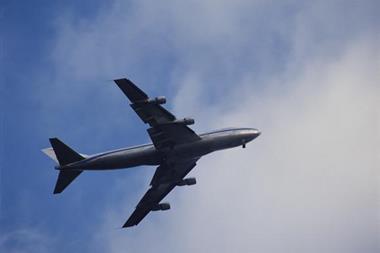A Met forecast puts the ash cloud directly over London at 6pm causing more disruption to flights
A cloud of volcanic ash caused by the eruption of the Eyjafjöll volcano in Iceland is sweeping across Britain, disrupting flights across the country, according to reports.
A set of charts issued by the Met Office show how the cloud is set to spread south towards London today (April 15), at about 6km above ground.
The chart opposite shows the Met Office forecast for the cloud at 6pm this evening.
The area inside the red line shows the risk of ash at lower levels, between ground and 20,000 feet. The green line is the risk of ash above 20,000 feet to 35,000 feet, while the blue area shows the cloud above 35,000 feet to 55,000 feet.
Hundreds of flights in Britain have already been cancelled. The forecast for the spread of the cloud suggests more disruption to flights later in the day.
Volcanic ash is silica-based material and highly abrasive. It is capable of causing major damage to aircraft through clogging engines and causing them to flame out, and by scouring windscreens so as to make them opaque.
Over the past few decades there have been more than 80 encounters between civil aircraft and ash clouds, resulting in a number of situations wherein crashes have only narrowly been avoided, according to Aon Benfield.
An encounter in 1982 between a BA 747 and an ash cloud from Galunggung volcano in Indonesia resulted in engine failure. The plane dropped 7,000 m before the engines could be restarted.
The last notable occasion when ash from an Icelandic volcano reached the UK was 1783 following a major eruption of volcano Laki. The cloud of ash lay across Europe from the summer of that year and into 1784.
Professor Bill McGuire, professor at the Aon Benfield UCL Hazard Research Centre, said: “The [Laki] cloud resulted in elevated summer temperatures and resulted in poor air quality that caused a significant increase in mortality in the UK and elsewhere in Europe.”
In relation to the current eruption, he continued, it is worth noting that the last eruption of Eyjafjöll lasted more than 12 months. If this eruption has a similar duration then ash could periodically present a problem in UK air space.
The 1600m high Eyjafjöll volcano (also known as Eyjafjallajökull) is located in southern Iceland, immediately west of Katla volcano. Eyjafjöll is an elongated, ice-covered volcano topped by a 2.5 km wide summit caldera. The volcano appears to have been relatively inactive over the last 10,000 years, and the sole historical eruption, prior to this year, occurred in 1821.



















